#繁體中文
Text
When I was eating out with Mr. Baba from Dragon Ash before he passed away*, we happened to talk about hide, and he said “People really die when others forget about them”... That’s why our loved ones who passed away will live on within us as long as we remember them.
Toshiya
(*Mr. Baba was the bassist of Dragon Ash. He passed away on April 21, 2012 at his home due to acute heart failure.)
. . .
Dragon Ash的馬場桑去世*之前,我曾經和他單獨吃飯。談到hide桑時馬場桑說:「人只有在被遺忘時才會真正迎來死亡」…所以只要我們這些還記得的人仍然活著,那些已經逝去的、我們所喜愛的人就會一直活在我們心中。
Toshiya
(*Dragon Ash的貝斯手馬場育三於2012年4月21日因急性心臟衰竭在家中過世)
37 notes
·
View notes
Text
【總整理】數十款免費「可商用」中文 字型,讓設計更有質感!(2022.9.5更新)
字型對於美工、設計師、影片剪輯都相當重要,不同的字體還能表達不同的情緒。不過,重點是這些字型必須支援個人或商業使用,才不會觸及授權及法令問題。這篇整理所有本站介紹過的開放原始碼及 OpenType 字型,提供需要的朋友下載使用,讓文字更有質感與設計感。
不過,字型官方提供者有可能會調整授權方式,所以為了安全起見,大家在使用字體前,請再看一下當時官方條款是否有提供商用才準確喔!
(more…)

View On WordPress
0 notes
Text
Mandarin Reading Material Recommendation
Wed Sep 13 2023
Topic: Religion
If you are religious or enjoy studying various religions there are mandarin translations of the most popular religious texts and possibly more! It's best if you've already read these texts in your native language though, it helps with context to learn faster.
Here's some links:
Bible (Simplified) (Traditional)
Quran (Simplified) / (Simplified) (Traditional)
Dao De Jing (Simplified) (Traditional)
Tripitaka (Simplified) (Traditional)
#chinese langblr#mandarin langblr#learn chinese#chinese lesson#chinese vocab#chinese to english#religious language#religious texts#religious studies#religion study#中文#聖經#古蘭經#繁體字#bible#old testament#quran#koran#tripitaka#dao de jing#daoism#christianity#islam#buddhism#language learning material
12 notes
·
View notes
Text
SQL 2008 R2安裝 標準版授權,架設地端資料庫服務【細節教學】
SQL Server 2008 R2看到這則安裝教學,應該不少讀者覺得這是個古董級資料庫服務了吧!老黑只能說這只是個開胃菜,這版授權可是目前老黑販售最多授權,也是目前不少企業仍在使用的SQL服務,為了避免記憶衰退依然要把架設地端微軟資料庫服務的技巧分享一波…如果你剛好有需要就拿去服用吧…
Continue reading SQL 2008 R2安裝 標準版授權,架設地端資料庫服務【細節教學】
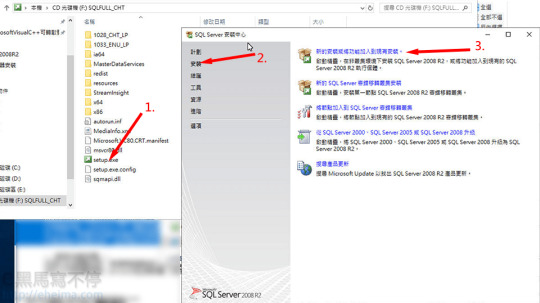
View On WordPress
0 notes
Text
Telegram 中文化怎麼用?iOS、Android 與電腦版 TG 中文版設定 只要點擊1個連結即可改中文!
Telegram 是一款隱私性極強的免費通訊軟體,跨平台支援手機與電腦,不過當你下載 Telegram 後,應該會發現它預設是英文版,這是因為 Telegram 官方沒有提供中文版本。但沒關係,本篇 Telegram 中文化 教學會詳細教大家怎麼將 Telegram 手機版(iOS、Android)與 Telegram 電腦版改中文,只要使用本文提供的 Telegram 中文版軟體包連結即可一鍵將 TG 中文化。

完整內容:工具仁 telegram 中文化
看更多實用工具就在工具仁ToolMan
1 note
·
View note
Text
hehe. its soo crazy 一年前我什麼繁體字都看不懂但現在我只用繁體來寫中文 wooooo i worked so hard this year fr.
0 notes
Text
whenever people use simplified Chinese in my Chinese class I die a little bit inside
#the tests are all in traditional#why#we’re going to Taiwan#stop using simplified#traditional ftw#I just think traditional is more fun#繁體話#中文
0 notes
Text
鯊顫線上看完整版小鴨【繁體中文配音】
《鯊顫》線上看完整版小鴨,鯊顫線上看,完整版小鴨影音繁體中文配音。
就能免費線上看邱澤電影《鯊顫》,而且還是原廠正版HD畫質。
鯊顫線上看、繁體中文配音 :
➤https://fliktv.net/zh/movie/960258/shark-bait
台灣 No.1 高清正版線上看 | 460p - 720p - 1080p - BRRip - DvdRip - 4KUHD
#鯊顫線上看#鯊顫線上看完整版#鯊顫線上看小鴨#鯊顫線上看完整版小鴨#鯊顫線上看完整版免費#鯊顫線上看小白影音#鯊顫線上看完整版高清免費#鯊顫線上看中文#鯊顫線上看繁體中文配音#鯊顫線上看繁體中文字幕
1 note
·
View note
Text
kickstarter

Heart Cage, an 18+ upcoming mystery otome game with all yandere love interests, is now on Kickstarter!
"You are a detective who has just moved to a new town. You are involved in a serial killer case, and three mysterious residents (Or more?!) are approaching you!
Don't trust anyone! But... can you?"
Demo features:
♥ custom name
♥ 8k words(for demo)
♥ 11 CGs (with one NSFW cg)
♥ Fully voiced!
♥ 3 love interests (more in the full version!)
♥ You can choose both NSFW mode or SFW mode, SFW mode is safe for streaming!
♥Available Languages: English (US), 繁體中文
You can try the demo (18+) or support the game here!
#otome game#otome games#heart cage#yandere#male yandere#upcoming#trial#kickstarter#crowdfunding#support#ricelovecoffee
288 notes
·
View notes
Text
【中譯】薫の読弦--第二十九章「進化退化與不變的15年」
原文發布於2014年9月,薰比較了當時他們正在製作的《ARCHE》和主流出道的第一張專輯《GAUZE》的錄音過程。
— —
Kaoru compared the recording process of "ARCHE", which they were working on at the time, and their debut album "GAUZE".
As far as I know, there is no English translation of this article yet.
#dir en grey#薫#kaoru#dokugen#読弦#kaoru translation#中文翻譯#繁體中文#translation by yinfu#link post#link to my blogger
12 notes
·
View notes
Text
🍓 that girl diaries // i just wanna have my cake and eat it too 🍰


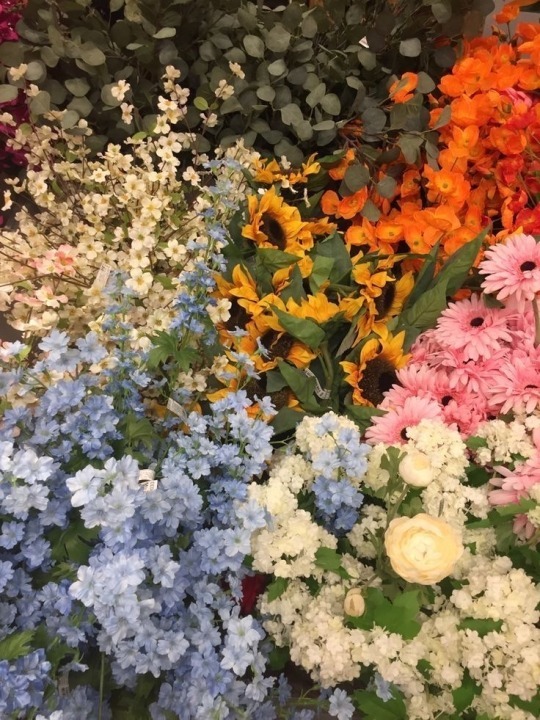
今天我不可以運動因為我的身很疼的。我的醫生說從現在我也不可以跑步。我很傷心。跑步是我的最喜歡的之一運動。而且現在我用繁體中文版因為拼音一樣的。只是好玩,哈哈 😅 (today i can't exercise because my body is in pain. my doctor said from now on i also can't run. i'm very sad. running is one of my favorite exercises. also now i'm using the traditional Chinese version because the pinyin is the same. just for fun, haha 😅)
📚 read a chapter of Sophie's World — the last time i slogged through a book like this i was reading an English translation of The Pillow Book and i swore i wouldn't let it happen again... oh, well 🤷♀️
📝📝 Japanese lessons
🎧 Chinese small talk practice — now i can suck at small talk in 3 languages 🤣
🧠 Danish instrumental + writing assignment
📝📝 Chinese lessons
📝📝 Korean lessons
🎧 Chinese cleaning vocab because spring cleaning continues today!
❤️ spring cleaning + cinema therapy
🎧 Japanese vlog + Chinese vlog both from みきさん/Miki姐姐,我的非常非常喜欢的vlogger
💌: mentally, i feel much better today. physically, it's worse. i guess that's just equilibrium, 對吧? 哈哈哈哈哈哈... 😑 google, play fml 💀
#studyblr#langblr#chinese langblr#japanese langblr#korean langblr#study motivation#study inspiration#study aesthetic#100 days of productivity#100 days of studying#100 days of self discipline#self improvement#self development#glow up#that girl#it girl#dream girl#astudentslifebuoy#heydilli#zesty's life#student life#studyspo#pink aesthetic#pinterest girl#clean girl#becoming that girl#bookblr#currently reading#currently listening to#currently watching
72 notes
·
View notes
Text
【總整理】數十款免費「可商用」中文 字型,讓設計更有質感!(2022.5.29更新)
字型對於美工、設計師、影片剪輯都相當重要,不同的字體還能表達不同的情緒。不過,重點是這些字型必須支援個人或商業使用,才不會觸及授權及法令問題。這篇整理所有本站介紹過的開放原始碼及 OpenType 字型,提供需要的朋友下載使用,讓文字更有質感與設計感。
不過,字型官方提供者有可能會調整授權方式,所以為了安全起見,大家在使用字體前,請再看一下當時官方條款是否有提供商用才準確喔!
(more…)
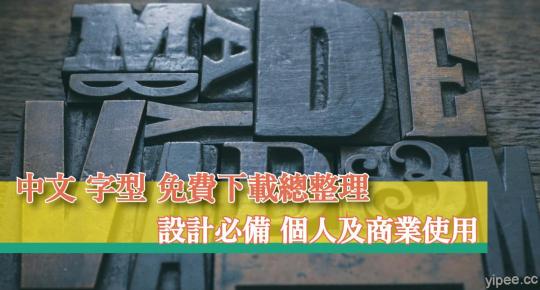
View On WordPress
0 notes
Text
Random Stuff #12: What is Simplified Chinese?
For people like me who grew up speaking and using Chinese in day to day life, the vast majority of us have at least a basic understanding of what Simplified Chinese is, but it wasn’t until some days ago when an English speaker asked me “what is Simplified Chinese?” that I realized not many people here understand what Simplified Chinese is. So, I’ve gathered some misconceptions I’ve encountered both in real life and online, and I will try to answer them in a concise but factual manner.
But first, let us talk basics. There are three things we must cover first before going into this topic. The first is the fact that both Simplified Chinese (简体中文) and Traditional Chinese (繁體中文) used today are modern standardized systems of written Chinese, as in both were compiled within the past 100 years or so (modern Simplified from 1935-1936, then again from 1956 and on; modern Traditional starting from 1973), and the two currently widely used versions of both systems were officially standardized in the past 50 years (modern Simplified current version standardized in 2013; modern Traditional current version standardized in 1982). However, since simplified characters already exist in history (called 简化字/簡化字 or 俗体字/俗體字/”informal characters”), and “Traditional Chinese” can be taken to mean “written Chinese used in history”, in this post I will use “modern Simplified/Traditional Chinese” or “modern Simplified/Traditional” when referring to the currently used modern standardized systems.
Second is the evolution of written Chinese. Usually when this is taught, instructors use examples of how certain characters evolved over time, for example one might encounter a linear diagram like this in Chinese class:

(Original picture from Mandarinpedia)
However, this diagram only gives a very general idea of how characters evolved from more picture-like logograms to the more abstract symbols we call characters today, and does not reflect the complexity of this evolution at all. To get into these details we will need to talk about Chinese calligraphy. In terms of the evolution of written Chinese, Chinese calligraphy--all those scripts like oracle bone script (甲骨文), bronze/Jinwen script (金文), Seal/Zhuan script (篆书/篆書), Clerical/Li script (隶书/隸書), Regular/Kai script (楷书/楷書), etc--they aren’t just calligraphy fonts, but actually change the way characters are written, and are representative of the commonly used forms of written Chinese at different points in Chinese history, as in the appearance of a certain script on a historical artifact can actually be used to estimate how old the artifact is. Below is a (very) rough timeline of when each script appeared and when they are most popular:
Oracle bone script/Jiaguwen (甲骨文): Shang dynasty (~1600 BC-1046 BC)
Bronze/Jinwen script (金文; includes Large Seal script/大篆): Western Zhou dynasty (~1046 BC-771 BC)
Seal/Zhuan script (篆书/篆書; sometimes called Small Seal script/小篆 or Qin script/秦篆): compiled in Qin dynasty by chancellor Li Si/李斯 around 221 BC, was the official script in Qin dynasty (221 BC-207 AD); popularity went down after Qin dynasty but was still in use for ceremonial purposes like official seals (the archaic meaning of 篆 is “official seal”, hence the English name); still in use today in very specific areas like seal stamps, calligraphy, logos, and art.
Clerical/Li script (隶书/隸書): appeared in Qin dynasty, became the main script used in Han dynasty (202 BC-220 AD); popularity went down after Han dynasty but was still in use; still in use today in specific areas like calligraphy, inscriptions/signatures on traditional Chinese paintings, logos, and other art.
Regular/Kai script (楷书/楷書): appeared in late Han dynasty, became the main script used in Tang dynasty and has been popular ever since (618 AD-present).
(Note: there are other calligraphy scripts like Semi-Cursive script/行书/行書 and Cursive script/草书/草書 that were never mainstream yet were also significant, especially in the case of modern Simplified Chinese, but I will mention them later so this won’t become too confusing)
So if we plug the information from the very rough timeline above into the linear diagram, it becomes this:
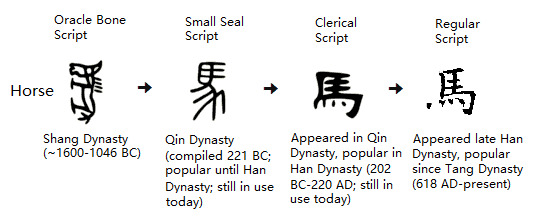
But wait! There’s even more! Because there is a thing called variant Chinese characters/异体字/異體字, which basically means that there have been multiple ways in which a character can be written (“one character, many forms”/一字多形), and these can come about as a result of homophones, personal preference of historically significant people, historical trends, mistakes in the past that stuck around, or the result of stylized scripts like Cursive script/草书/草書, which simplifies and connects strokes in a liberal manner. The reason Cursive script is important here is because of the logographic nature of written Chinese, meaning the simplifying or connecting of strokes actually changes how the character is written. Because of this, 马 and 馬 were forms that have already existed before modern Simplified and modern Traditional were compiled. A diagram that takes variations and evolution into account should look something like this:
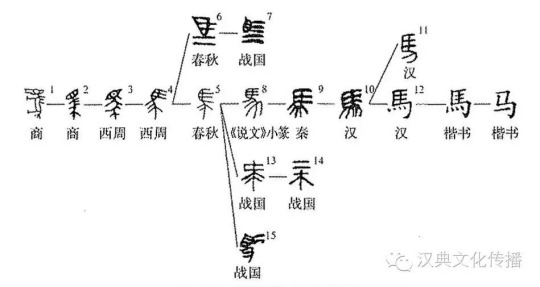
And since the above diagram did not take Cursive script into account, here’s another picture of a myriad of scripts/fonts (not in chronological order) that includes 馬 in Cursive script (mostly on bottom left):
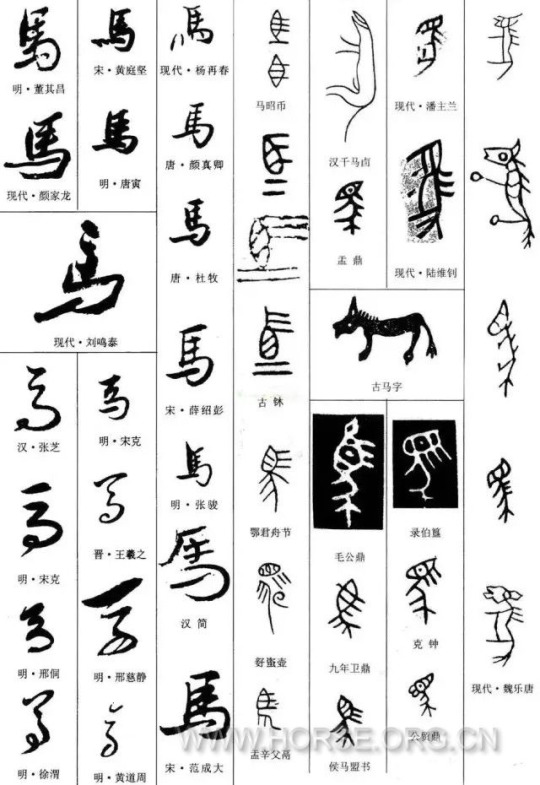
Now you may have an idea of where modern Simplified and Traditional Chinese came from: they are both compiled from existing variants. Since both modern Simplified and modern Traditional are supposed to be standardizations of written Chinese, they each set a single variant for each character as the “standard”. Modern Traditional Chinese kept the more historically mainstream 馬, and modern Simplified Chinese substituted it with the simpler variant 马. Taking all of this into account but still keeping it concise for our topic here, our linear diagram from the beginning should be modified to look like this:
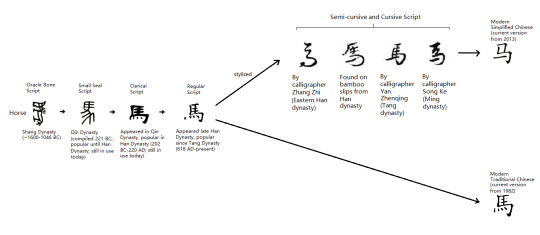
And that’s just an example of a single character. This evolution diagram can differ depending on the character too, due to there being other rules for simplifying characters. This is why standardizing written Chinese is an immense amount of work, but once standardized, the written language will be streamlined and much easier to use in communication.
Finally, we are ready to clear some misconceptions.
---------------------------------------------------
About Common Misconceptions Regarding Modern Simplified Chinese:
“Simplified Chinese replaced all Traditional Chinese characters”. Untrue. Modern Simplified Chinese only standardized 2274 of the most used Chinese characters and 14 radicals with simpler variants. That’s really all there is to it. For reference there are a total of about 60,000 Chinese characters, and about 3,500 of these are deemed to be often-used characters; so only ~3.7% of all Chinese characters and ~65% of often-used Chinese characters are simplified in modern Simplified Chinese. Play around with any online tool that can switch between modern Simplified and modern Traditional, and you will find that many characters stayed the same.
“Simplified Chinese is the opposite of Traditional Chinese”. Untrue. Modern Simplified Chinese is just a simplified and standardized system of written Chinese. Modern Simplified Chinese and modern Traditional Chinese are not “opposites” of each other at all, just different standardized systems serving different purposes. Modern Simplified was compiled with ease of use in mind, since Traditional characters can be time-consuming to write, for example imagine writing 聲 (sound) when you can just write 声 instead. Also back when Simplified was being introduced to the public, a huge part of the population was illiterate, especially farmers, poor people, and women, so Simplified Chinese was a great way to quickly educate them on reading and writing, and to improve efficiency in all aspects of life. Knowing how to read and write is key to education, and education is a must if people's lives were to be improved at all.
“Simplified Chinese is Mandarin”. Untrue. Mandarin is a spoken dialect that came from Beijing dialect, and both modern Simplified and modern Traditional Chinese are modern standardized systems of written Chinese. One concerns the written language and the other concerns a spoken dialect.
"Simplified Chinese was invented by the Communist Party". Untrue. As mentioned before, most characters used in modern Simplified Chinese are already present in ancient texts, artifacts, and inscriptions as variants. Apparently the only character simplified by PRC was 簾 (blinds/curtain), which became 帘 in modern Simplified Chinese. History wise, Republic of China was the first to start compiling Simplified Chinese in 1935 and introducing it to the public, but this was called off after 4 months. PRC modified and built on the original plan, and introduced it to the public again starting from 1956.
"Simplified Chinese is to Traditional Chinese as Newspeak is to English in 1984". Completely untrue. Modern Simplified Chinese is just a simplified way to write commonly used Chinese characters and does not alter the meaning of the characters. There are some Traditional characters that are combined as one simplified character in modern Simplified, but the meanings are not lost or altered. For example, 發 fā (development) and 髪 fà (hair) are combined as 发 in modern Simplified, resulting in 发 having 2 different pronunciations (both fā and fà), and each of these pronunciations carrying their original meaning. The meaning of neither 發 nor 髪 was lost, 发 will just have a longer dictionary entry.
"Simplified Chinese is a huge change from Traditional Chinese". Only partly true in that it is a change, but it is a change justified by the evolution of written Chinese throughout history. The origin of most modern Simplified Chinese characters come straight from history itself, since many characters had alternative ways in which they were written (sometimes for convenience), for example these characters below. Each row contains different forms of a single character (smaller characters indicate what time period these variants are from; ex: 汉碑 means the variant is from a Han dynasty inscription).
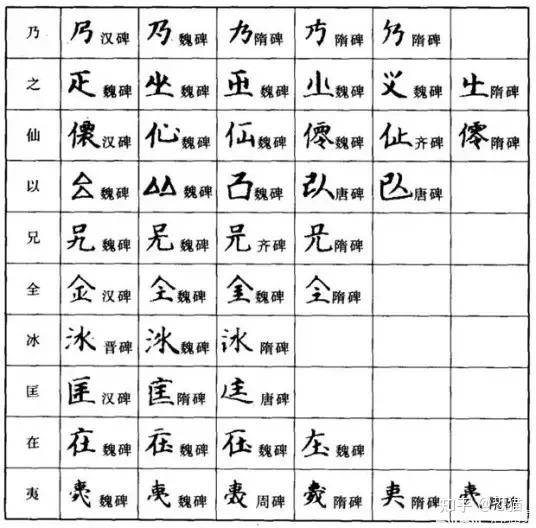
In reality, written Chinese has always been standardizing itself. Less-used variants become forgotten over time, sometimes only rediscovered through archaeology. Besides, effective written communication does partly rely on standardization of the written language (imagine everyone writing in the various variants...how horrible would that be?). Modern Simplified just took this one step farther and made some characters easier to write.
“Traditional Chinese is no longer used in Mainland China”. Untrue. Modern Simplified is the commonly used form in Mainland China, but Traditional is still used in a variety of places, such as on store signs/brand logos, particularly for stores/brand that are old. For example the old Beijing brand 天福号 below (est. 1738). On their logo, 天福号 is written as 天福號 from right to left, which is the traditional way of writing horizontally.
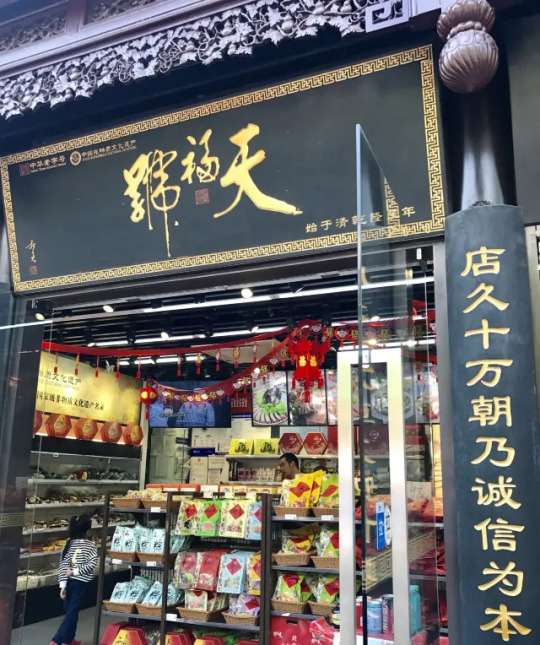
Traditional Chinese is also used in the logos for many universities in China:

Another way in which Traditional Chinese is commonly used in mainland China are personal seal stamps. Often times when people carve seal stamps for personal use (for example showing ownership on artwork they created or collected), they would put their name/courtesy name/nickname on the seal stamps in Zhuan/篆 calligraphy font, and Zhuan font use Traditional Chinese. Of course, the ways in which Traditional Chinese is still used in mainland China isn’t restricted to these two examples here. There are other places where Traditional Chinese is still used, such as traditional paintings/国画, calligraphy/书法, and many many more.
“People who grew up reading Simplified Chinese cannot read Traditional Chinese”. Depends on who you are asking. I grew up learning only modern Simplified, and I can read Traditional/modern Traditional Chinese just fine without having to actually learn it from anyone. Most people who grew up with Simplified Chinese should be able to read at least some Traditional without help. There are some people who say they can’t read Traditional without taking the time to learn it, but I doubt they’ve really tried, to be very honest.
---------------------------------------------------
And that’s it for the misconceptions!
My personal philosophy regarding modern Simplified Chinese and modern Traditional Chinese can be summed up as 识繁写简, or basically “know how to read Traditional and know how to write Simplified”. In a way, knowing how to read Traditional is a bit like knowing how to read cursive: a lot of history could be lost if we completely stopped using/learning about Traditional Chinese, but to meet the fast pace that modern life demands, I think modern Simplified Chinese is the more convenient choice for writing for day-to-day purposes. Since quite a few posts on this blog concern history, you will find that I usually use both Traditional Chinese and Simplified Chinese for historical things, since modern Traditional Chinese is closest to what people used in the past, and modern Simplified Chinese is more often used now. If it appears that I didn’t put modern Simplified and modern Traditional side by side, that usually means either the characters stayed the same and there’s no need for me to type the same thing out again, or the topic does not call for both to be shown.
Finally, the fun part. Here’s a Seal/Zhuan script calligraphy work by Mi Fu/米芾 (1051-1107):

Does something look familiar there?
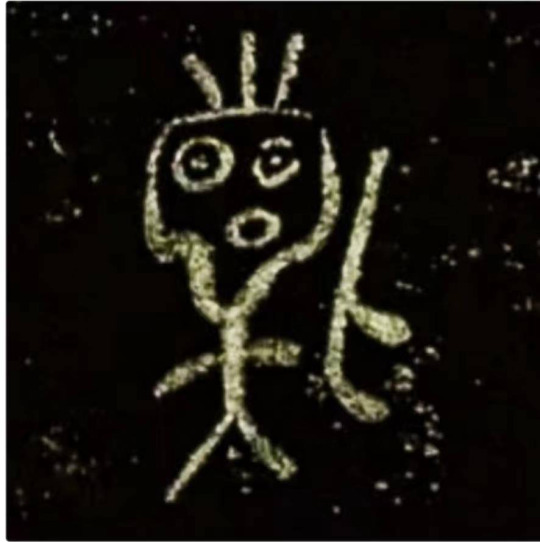
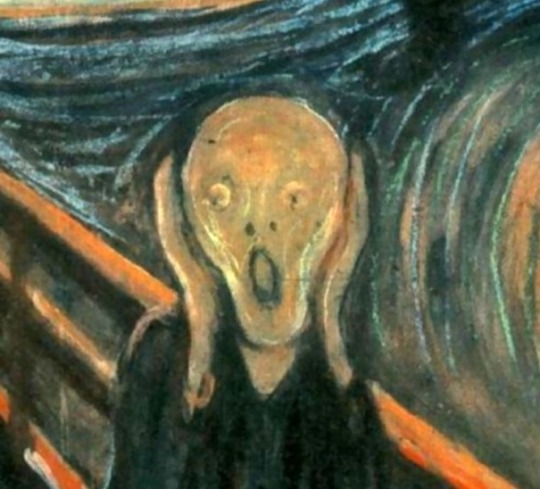
#simplified chinese#chinese language#language#written language#traditional chinese#chinese calligraphy#chinese history#random stuff#what is simplified chinese
990 notes
·
View notes
Text
Essential Traits Updates & Translations Added
UPDATE: 100 Base Game Traits V1.6

Fixed unharmful Invalid Tunings that cause the traits to appear on BE warnings. It is recommended to remove all your previous trait packages and redownload this updated version.
I moved Mute Trait to be standalone because I found the "silent voice" effect requires Seasons Pack
Added Talentless Trait as a replacement in Part 5
Renamed a few traits (Logical to Analytical, Absolute Pitch to Perfect Pitch, Charismatic to Charming, Abusive to Cruel) so that they are not to be confused with the skills or get interpreted in the wrong way.
UPDATE: Sorted Traits Picker v3.3
Added Support to my Mute Trait & 100 Base Game Traits V1.6

UPDATE: Mute Trait
The "silent voice" effect requires Seasons expansion pack. (No LE if you don't have that pack)
I separate this from 100 Traits because I found it was not BGC.
CAS & Reward versions available (can be used together); All Ages
Available in the reward store with XML injector
Can be added to Sims in gameplay mode with Sorted Traits Picker
👑 Info of Mute Trait
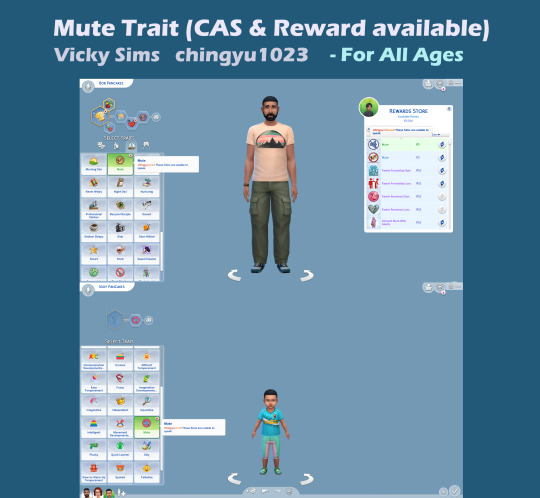
Translations Added:
Simplified Chinese 简体中文 & Traditional Chinese 繁體中文 translations by wenwenbalala. Thanks! (translations merged in mods)
Absent Emotion Traits Pack v1.3
Holiday Tradition Override v3.1
Friendzone Mod v2.1
CHANGELOG IN SEPTEMBER 2022
🔹 Links to ALL My Traits, Game Mods, and CCs
🔹List of IDs for creators who want to refer my traits to their own mods
🔹 List of Chingyu’s CC Traits Name and Descriptions for mod users
🔹 Check Mod Status after a patch & Compatibilities
👁🗨 Learn how to install a mod & FAQs
👁🗨 Terms of Use
👁🗨 Ask Questions/ Suggestions/ Bug Reports on Discord
▶ I need to see a screenshot or LE report to help you figure out what’s wrong!
👁🗨 Download on my Patreon
👁🗨 Follow me on Twitter
👁🗨 Follow me on Tumblr
#sims 4 traits#traits#trait#sims 4 cc#my cc#cc finds#the sims cc#s4 cc#ts4 finds#s4cc finds#ts4 download#ts4 gameplay#s4cc download#ts4 cc download#s4 download#sims 4 download#the sims 4 mods#the sims 4#the sims#s4ccfinds#s4cc mods#s4cc#s4ccmm#sims4cc#ts4mm#maxis match#ts4ccfinds#mycc#ts4 cc#ts4cc
826 notes
·
View notes
Text
喺4月30號呢日,
本應該係河國榮先生59歲嘅牛一,
一個小小嘅貼文向佢致敬。
On what would have been Mr Gregory Charles Rivers's 59th birthday this April 30th, a little post in tribute to him.
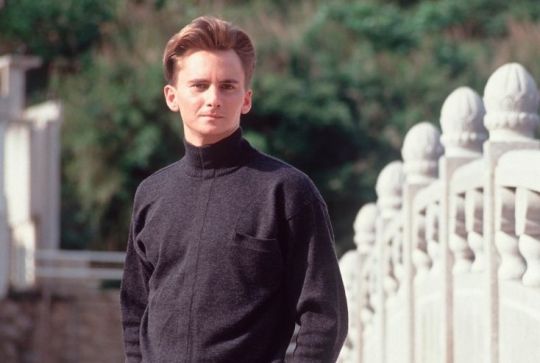



相 ①–②:80年代尾。啱啱嚟到香港冇幾耐,後生嘅河國榮。
Photos ①–②: The late 1980s. A young Rivers, still fairly new to Hong Kong then.
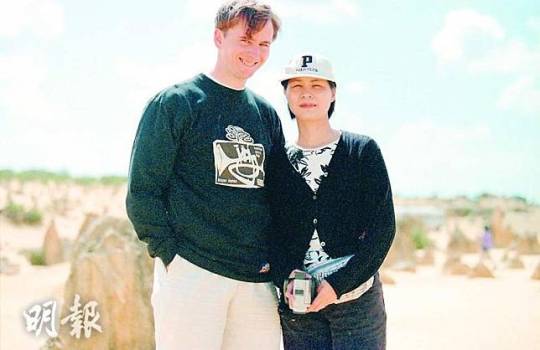
同太太Bonnie。兩人結婚卅幾年,夫妻一向恩愛。因為太太早有心臟病所以兩人早已決定唔要生仔。河太最終病情惡化比先生早先逝去。河國榮 (根據朋友口供) 哀傷過度,到最後決定跟隨太太。太太過咗身兩個月左右,好遺憾,河國榮選擇自盡。
With his wife Bonnie. The two had been lovingly married for over 30 years and decided not to have children because of Bonnie's heart condition. His wife's illness eventually took a turn for the worse. Rivers (according to friends) was overwhelmed with grief and regrettably, decided to join his wife barely two months after her passing.

同佢收養嘅狗仔。河生河太都好鍾意狗。有一陣仲收養咗總共十三隻狗仔添!
With his rescue dogs. Mr Rivers and his wife loved dogs and at one time had as many as 13 rescue dogs under their care!
喺呢部視頻裏面,你可以聽到河國榮翻唱緊由鄭少秋原唱嘅 《笑看風雲》 (首歌係我其中最鍾意嘅一首,仲覺得歌詞好有意義,我曾經翻譯過歌詞嘅意思,請參考一下)。雖然原片係由一個大陸歌唱比賽得到嘅,本片只得聽緊河國榮唱,冇得睇佢表演。但係有繁體字歌詞可以跟埋。
我特登揀咗冇比賽場面嘅視頻上載,因為覺得呢啲歌唱比賽嘅樣式好煩厭;感覺上睇得觀眾同評判嘅面孔多過睇得到台上表演緊嘅參賽者!但係如果想睇原片比賽視頻嘅話,都得!
In this video, you can hear Rivers performing a cover of Adam Cheng's 《笑看風雲》 (this song is one of my favourites, I found the lyrics very meaningful and did a translation before, please do check it out). Although the original video came with footage and is taken from a Mainland Chinese singing competition, this video only has audio, but it has lyrics in Traditional Chinese to follow along with.
I deliberately chose to upload a video without competition footage because I find these singing competition shows' format really annoying; feels like you'll often see more of the audience and judges' faces than the contestant on stage! But if you wish to view the original footage, here it is!
河國榮生前一直有個當粵語歌星嘅夢想。雖然始終冇機會當一個正式嘅歌手,但係多得佢多年嚟一直有好多港星朋友嘅幫助,都得到不少機會上台唱歌,甚至有機會舉辦小型演唱會添!佢小型演唱會賺嚟啲錢通常一部分都會捐到寵物救護中心。
During his lifetime, Rivers's biggest dream was to be a Cantopop star. Although he never did become one, thanks to his celebrity connections, he did get opportunities to sing on stage on several occasions, even managing to organise his own mini concerts with celebrity pals, of which part of his earnings often went to pet rescue shelters.
#I post this too in the hope people won't forget about you too soon!#Your love for your wife,dogs and contributions towards preserving#Cantonese#As a language and culture#Should be worth remembering#Gregory Charles Rivers#Canto Practise#Chinese Language#Language#Video#Cantopop#CMusic
10 notes
·
View notes